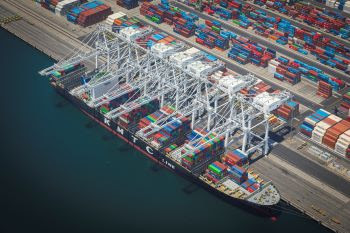Port of Long Beach officials are pointing to “softening consumer demand” and tariffs as the reasons for a nearly 4% cargo dip reported in September.
Dockworkers and terminal operators moved 797,537 twenty-foot equivalent units of cargo containers in September. That was down 3.9% from September 2024.
Imports decreased 6.9% to 388,084 TEUs and exports declined 3.6% to 85,081 TEUs. Empty containers moving through the port inched up by 161 containers to 324,372 TEUs.
Despite the decline in September, the port has moved 7,390,245 TEUs through the first nine months of 2025 — up 6.8% from the same period in 2024. It was also the port’s second-busiest quarter on record, with 2,643,614 TEUs moved from July 1 to Sept. 30.
But port officials have also warned for months of a slow down — which appears to have arrived.
“Tariffs are impacting how consumers and business owners make financial decisions and purchases,” Port of Long Beach CEO Mario Cordero said in a written statement. “Our Supply Chain Information Highway digital cargo tracker is forecasting a relatively stable October, followed by a slight decline in November due to anticipated weather-related delays and vessel scheduling changes.”
Directors of both the ports of Los Angeles and Long Beach have indicated they anticipate cargo flow to slow through the rest of 2025, a year that saw importers rushing to push cargo through before anticipated tariffs were implemented.
With holiday goods now in place at warehouses and stores, port officials said, the final quarter of 2025 is likely to see a slowdown of cargo coming through the West Coast ports.
Tariffs, Port of Los Angeles Executive Director Gene Seroka said earlier this week at his monthly virtual news conference, continue creating a rapidly changing and uncertain environment.
The Port of L.A. also saw cargo slow in September, with a 7.5% decline compared to the same month last year.
“As trade policy unfolds, we can only predict more unpredictability,” Seroka said. “When sweeping changes were first announced, importers abruptly stopped their orders from China. When those policies were softened and deadlines extended, cargo volume picked up again. The supply chain has been on a roller coaster all year and that ride continues.”
For complete Port of Long Beach cargo numbers, visit polb.com/statistics. Port of Los Angeles numbers can be viewed at the Portoflosangeles.org.

